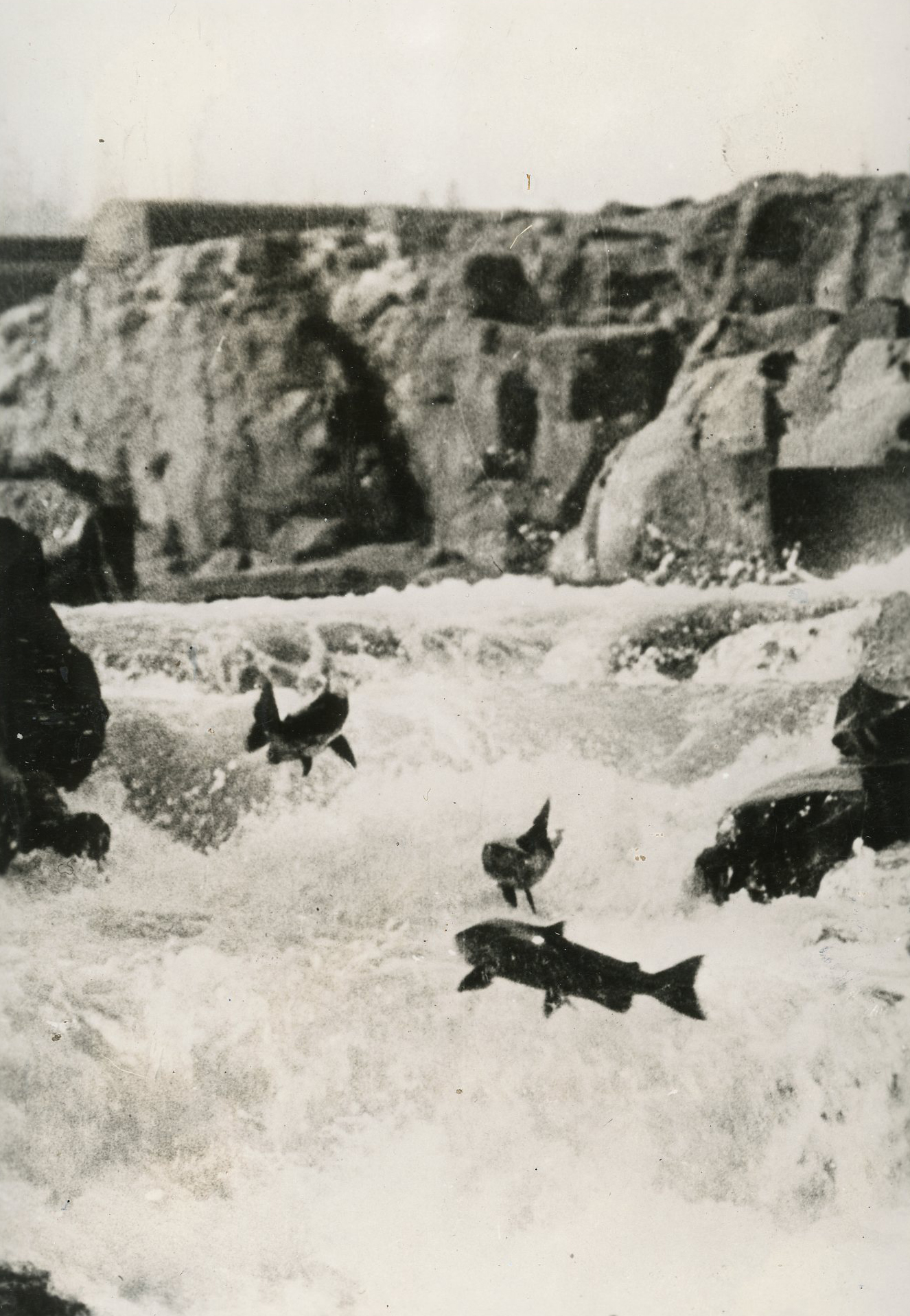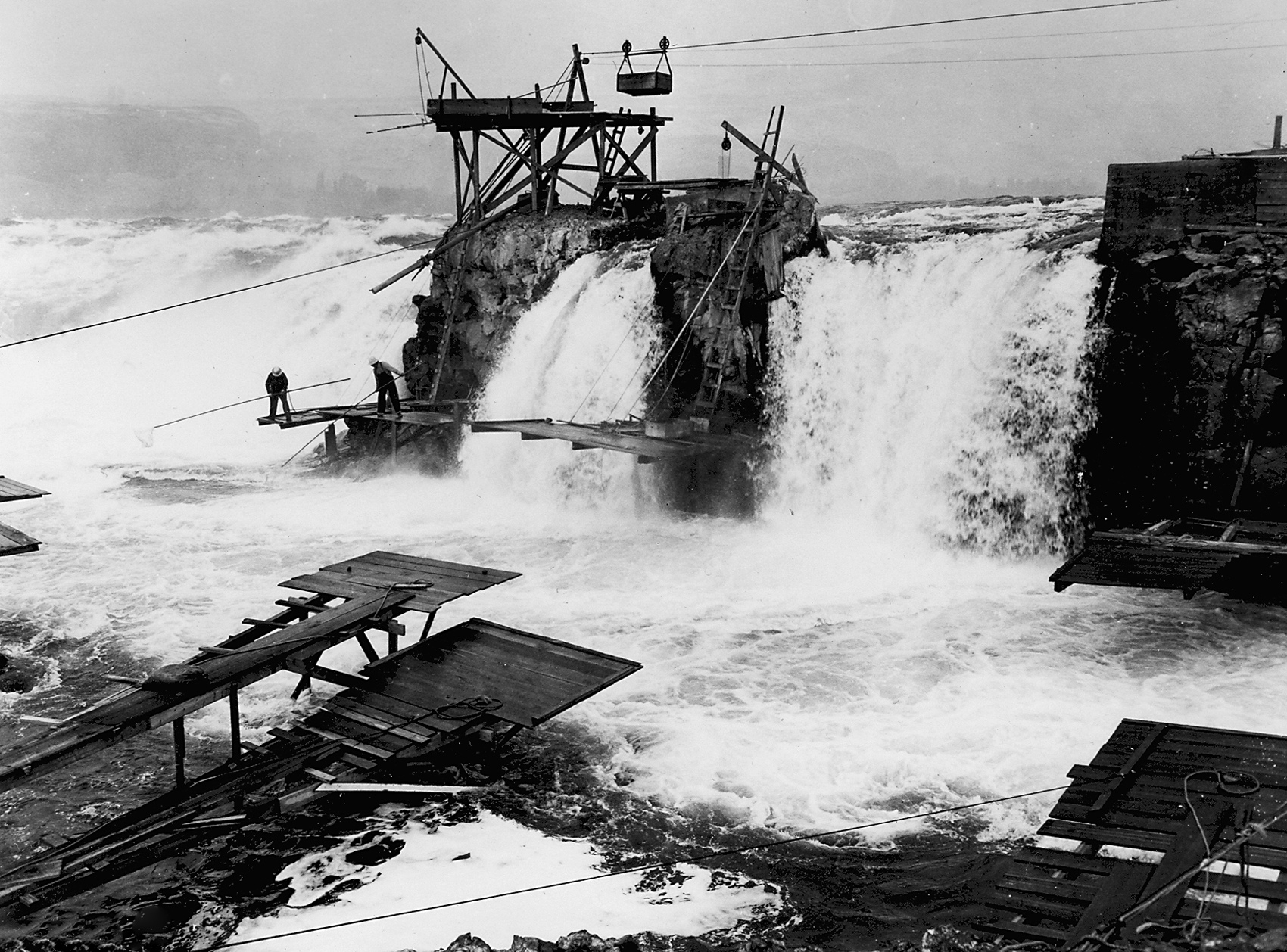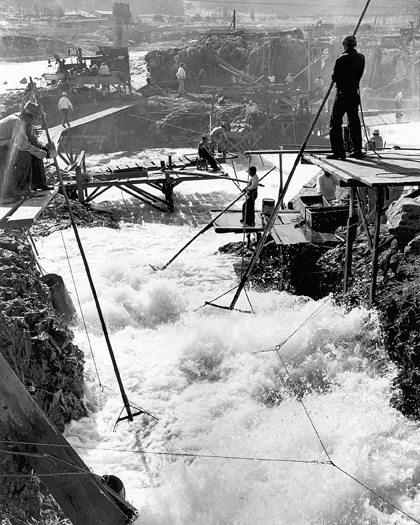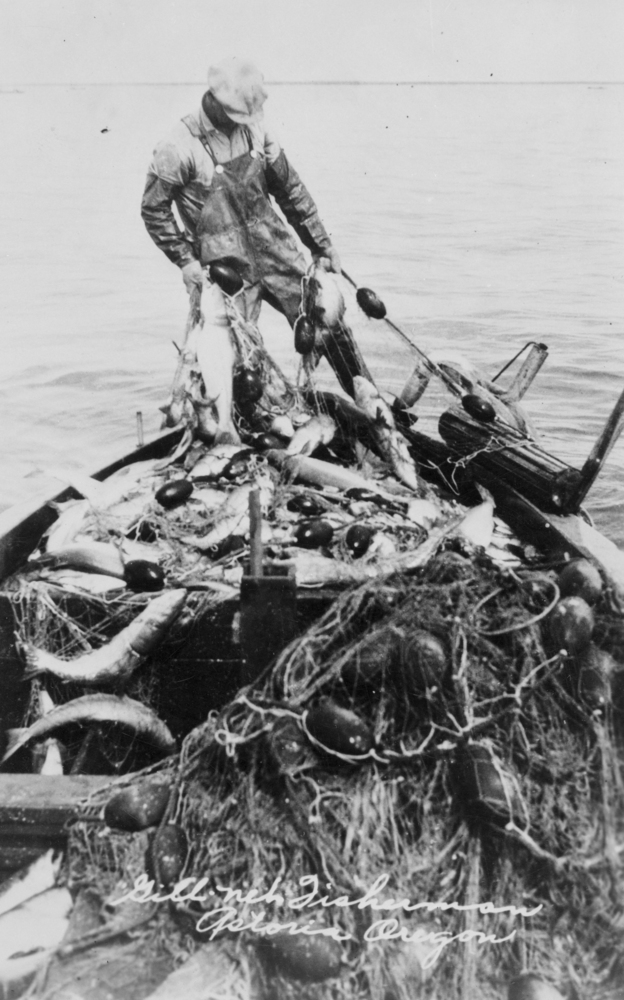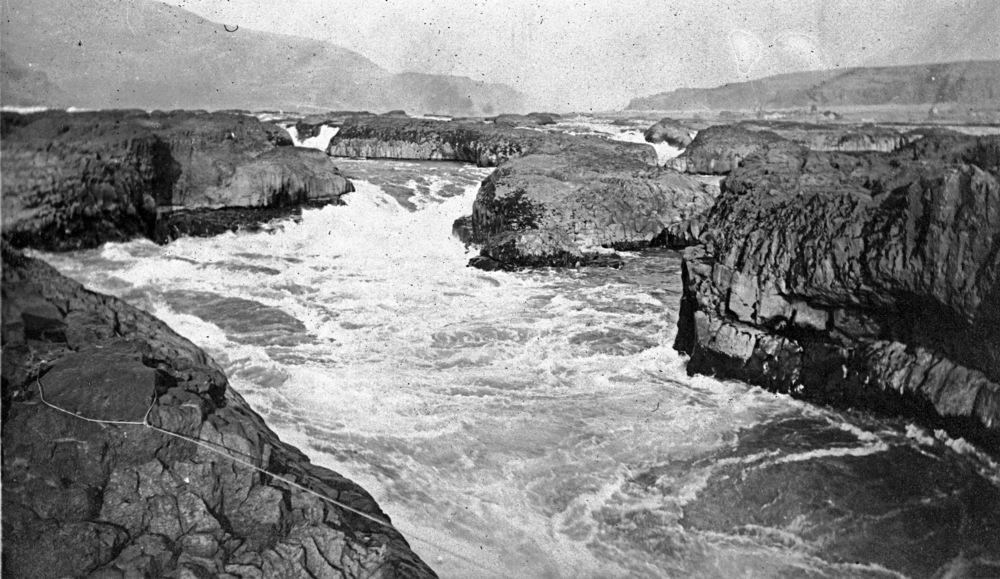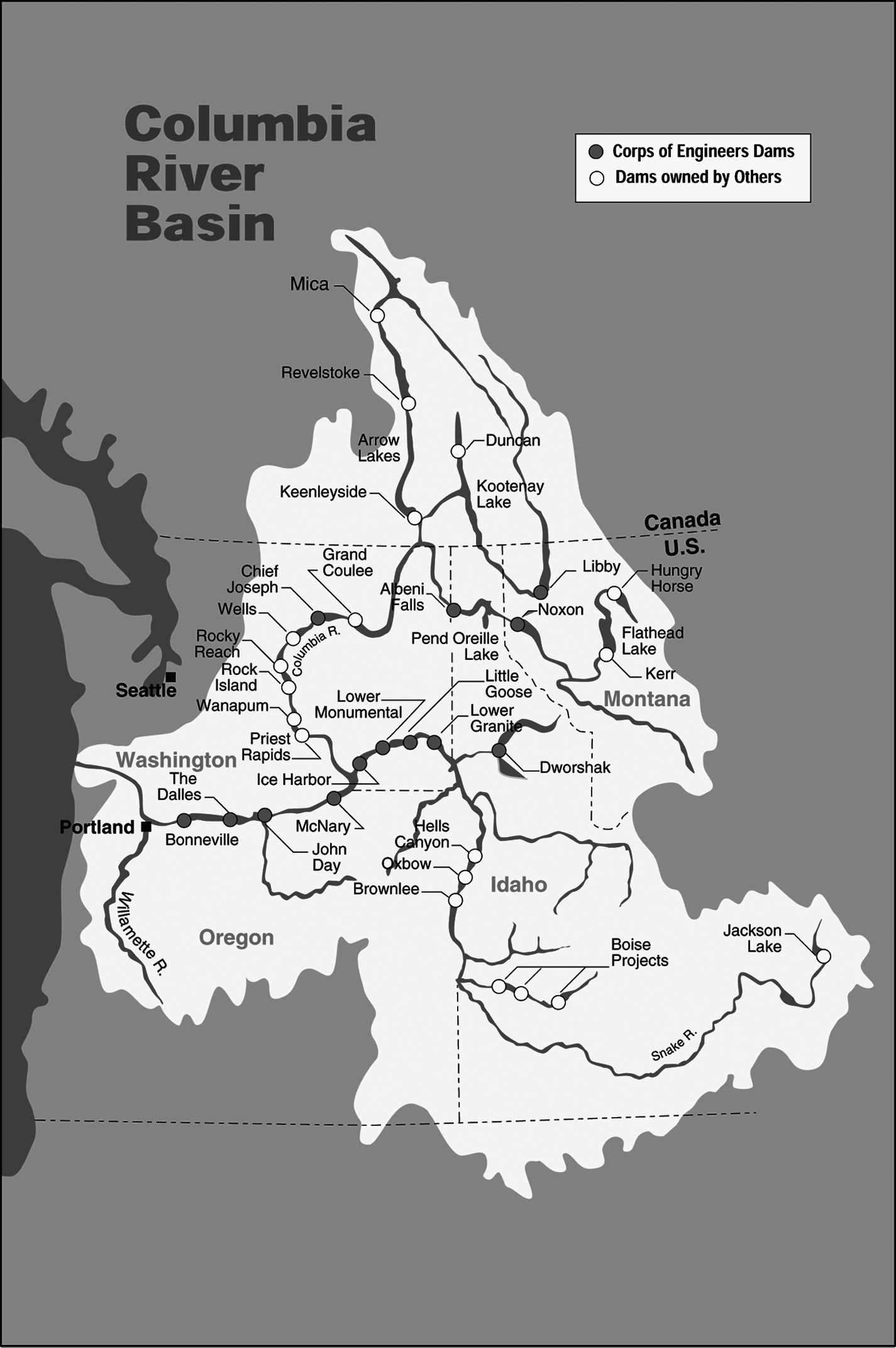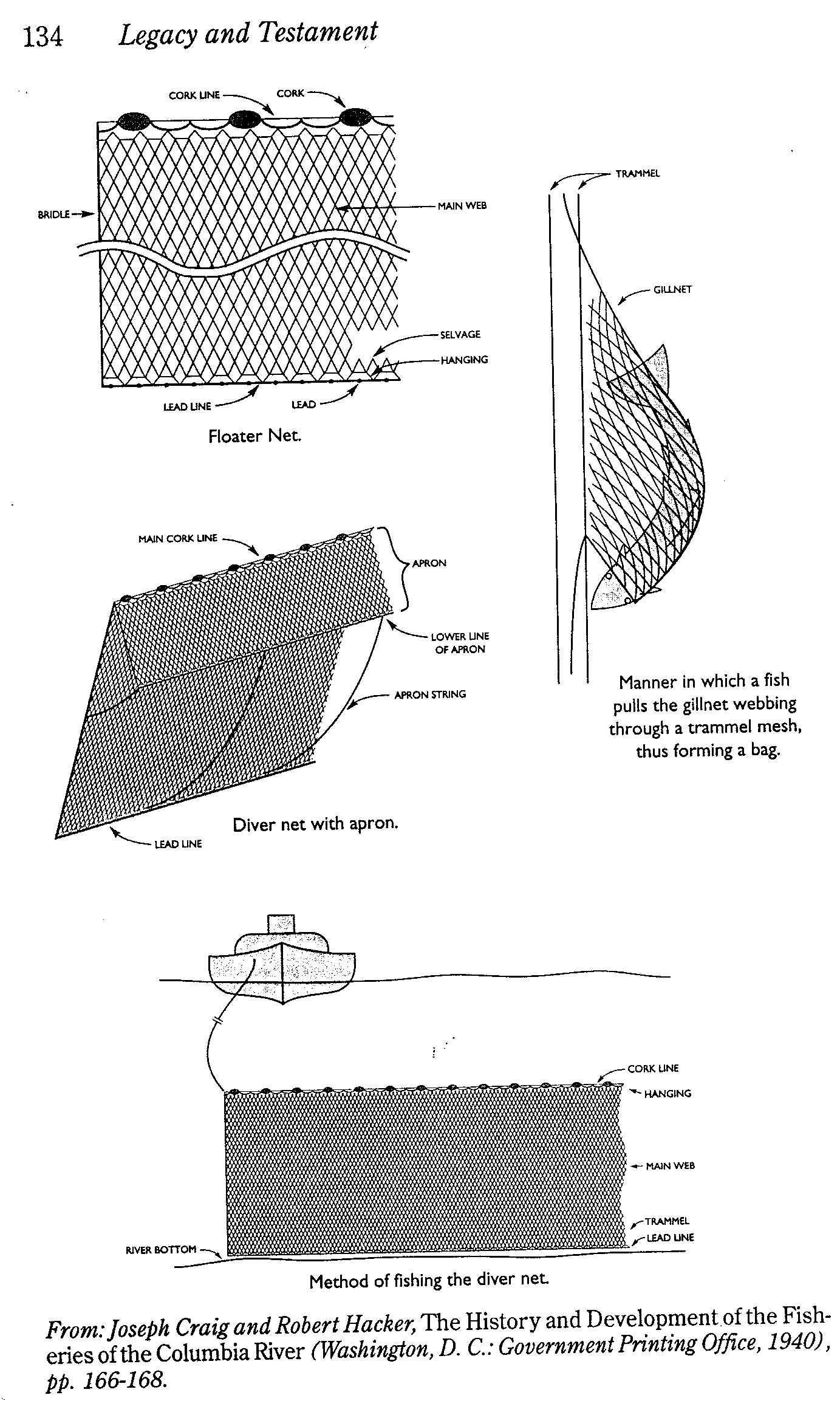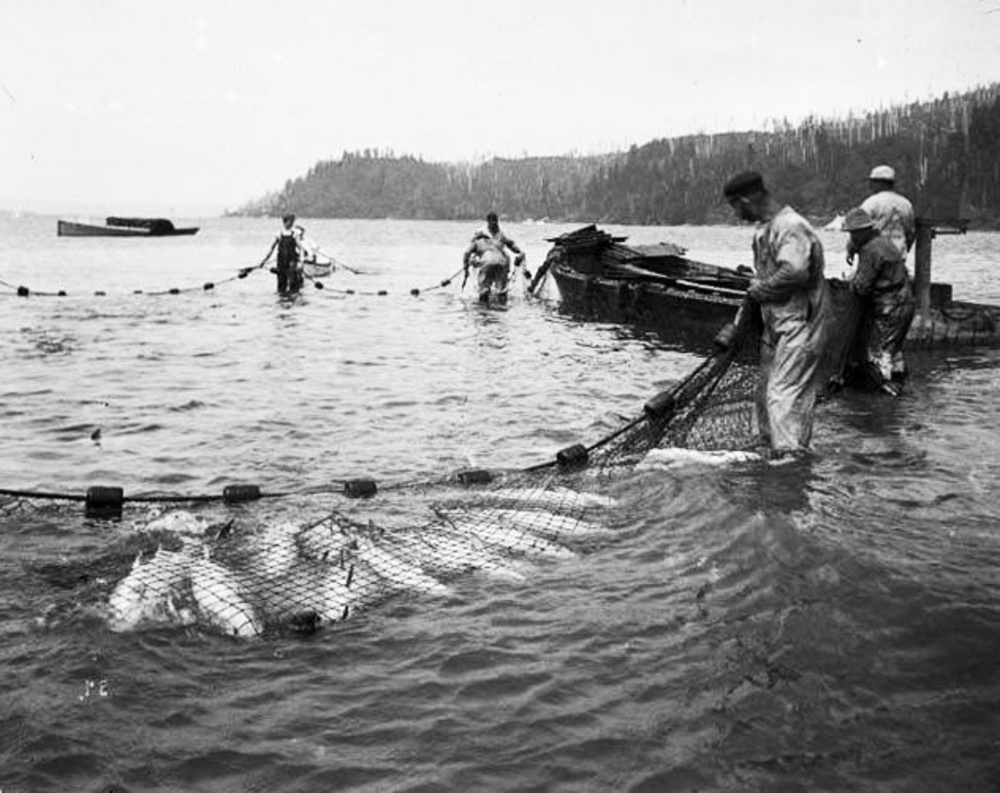The word “salmon” originally referred to Atlantic salmon (Salmo salar), a species native to the North Atlantic rim and Arctic Ocean above Western Europe. In 1792, however, the taxonomist Johann Julius Walbaum, following Georg Steller’s research on Kamchatka’s fishes on the Kamchatka Peninsula in the Russian Far East, applied the name to a group of fishes native to the watersheds of the North Pacific Rim and Arctic north of eastern Asia and western North America—Pacific salmon.
In Oregon, “salmon” applies to six species of the genus Oncorhynchus, known colloquially as Chinook (O. tshawytscha), coho (O. kisutch), sockeye (O. nerka), chum (O. keta), pink (O. gorbuscha), and steelhead (O. mykiss). Since the 1980s, aquaculture operations have also introduced S. salar to the inland seas of British Columbia and Washington State, farmed fish that escaped to colonize Pacific salmon spawning grounds from Washington to Alaska.
In general, salmon are anadromous, spawning in fresh water but maturing at sea. Most species are semelparous, spawning once before they die, and all require cool, oxygen-rich waters and clean spawning gravel. There is tremendous diversity within and between the species. When juveniles hatch from eggs, some migrate to sea immediately while others remain in freshwater for up to two years. Some steelhead and sockeye, called rainbow trout and kokanee respectively, never leave their natal streams, and Atlantic salmon, steelhead, and coho can spawn repeatedly.
Population Decline
For centuries, salmon has been a dietary staple of Indigenous peoples. Large, tasty, and available at predictable times and places, they are an ideal source of protein and easily caught with basic technologies such as spears, baskets, nets, and brush weirs. Northwest Coast cultures built elaborate rituals and taboos around fishing and featured salmon in oral traditions as spiritually powerful beings, inhabiting a role that anthropologist Dell Hymes called “the one who determines future destinies.”
Indians have traditionally harvested salmon across western Oregon and the Columbia River Basin, but a few sites hold outsized importance, including Willamette Falls, The Dalles, Celilo Falls, and Kettle Falls. Indigenous people from around western North American congregated at these places because the large runs could sustain huge crowds on a seasonal basis. People who lived around The Dalles also produced a unique commodity of dried salmon that members of the Lewis and Clark Expedition reported was packed into ninety-pound baskets, traded widely, and remained edible for up to two years.
Beginning with Robert Gray’s 1792 visit to the Columbia River, aboriginal fishers sold fresh and dried salmon to traders, explorers, trappers, and resettlers. In this respect, salmon became a fish of destiny for EuroAmericans, nourishing famished bodies and ameliorating scurvy. Salmon was also an important food and trade item for the Hudson’s Bay Company in the 1820s and 1830s, then for Indigenous and newcomer fishers who supplied white settlers, and eventually for the non-Indian industrial fishery.
Beginning in the mid-nineteenth century, in the name of production and progress, farmers, ranchers, loggers, miners, and townspeople rearranged the environment, dramatically altering terrestrial and aquatic ecosystems. They dammed, diked, dredged, grazed, logged, plowed, trapped, and urbanized nature. The elimination of beavers from watersheds streamlined streams, accelerating flows and making them less hospitable to juvenile salmon. Loggers built splash dams to form a head of water that could float logs to mills. The resulting flash floods scoured spawning gravels, and some salmon spawning beds were suffocated by increased siltation from forest fires, farming, grazing, and development.
Beginning in 1866 on the Lower Columbia River and extending up the Willamette, Snake, and coastal rivers and streams by 1890, industrial fishers used hooks, gill nets, seines, weirs, traps, and fishwheels to intercept salmon on their spawning runs. Total catches were statistically similar to Indigenous harvests, but the structure and method of fishing had changed. Industrial fishing occurred primarily in spring and early summer rather than year-round, and fishers congregated mainly in estuaries and lower rivers, not throughout watersheds. The salmon runs began to decline.
While non-Indians expressed little concern for salmon, state and federal agencies began to eye the declining runs with alarm. Having witnessed the implosion of salmon runs in 1830s New England and 1860s California, cannery owners in the 1870s lobbied Congress to protect Pacific salmon and their own investments. The U.S. Commissioner of Fish and Fisheries, who had declared that the artificial propagation of commercially valuable fish held the “power not only to maintain the present supply of fish indefinitely, but to increase it if desirable,” sent Chief Fish Culturist Livingston Stone to northern California in 1872 to establish the first Pacific salmon hatchery. When cannery operators formed the Oregon and Washington Fish Propagation Company to encourage federal intervention on the Columbia River in 1877, Stone returned to build a hatchery on the Clackamas River. That fall, canner R. D. Hume built a private hatchery on the Rogue River.
The decline in salmon runs on the Pacific Coast in 1877 was due to a severe El Niño. It was a temporary disruption, one repeated many times since, but no one knew that at the time. When better ocean conditions returned and the runs rebounded, observers concluded that hatcheries had saved the day. By 1890, state and federal hatcheries were seen as the backbone of Pacific salmon management even though no there was no scientific evidence that they had any effect on salmon runs.
Economic Interests
The salmon fisheries were beset by rivalries. Gilded Age tensions between labor and capital led fishers to organize the Columbia River Fisherman’s Protective Union in 1876 and to ally with the American Federation of Labor in 1885. Canners organized their own cartels, including the Alaska Packers Association in 1893 and the Columbia River Packers Association in 1899. Urban anglers formed clubs to lobby for their interests, increasingly seeking to displace commercial fishers. Hatcheries seemed to promise enough fish to avoid regulation, but the continued decline of runs in the 1890s and early 1900s inflamed tensions. The first great contest came in 1908, when each group used Oregon’s and Washington’s voter initiative processes to seize their rival’s share of the Columbia River salmon fisheries. The outcome was a stalemate, and each side returned to the ballot box in the 1910s and beyond.
Governmental efforts to ameliorate these tensions only exacerbated underlying problems. Federal and state agencies built hatcheries across the region, transplanted salmon eggs between watersheds, and generally operated in ways that undermined the genetic integrity of native stocks. When they failed to leaven runs, states restricted seasons and fishery technology. None of it offset the ongoing degradation of habitat. It was Native and industrial fishers who most consistently fought to protect habitat, protesting dam construction on the Columbia and pollution on the Willamette in the 1920s. Anglers blamed Native and industrial harvesters, which obscured the role of habitat change. Their tactics succeeded. By the mid-twentieth century Oregon and Washington had shifted harvest allocations almost completely to non-Indians, and they had zoned fishing in ways that relegated most commercial fishing to the ocean while anglers monopolized all rivers other than the Columbia.
Indigenous and commercial fishers bore the brunt of midcentury blame, even though hydroelectric, irrigation, and municipal water supply dams obstructed and inundated more streams. The first large dams rose at Willamette Falls (1888), Bull Run (1895), Swan Falls (1902), and Spokane Falls (1920). Then in the 1920s, federal investigators systematically charted additional sites across the Columbia Basin, and three mainstem dams followed in the 1930s: Rock Island (1931), Bonneville (1937), and Grand Coulee (1941). Grand Coulee was particularly significant, because it did not include fish passage, closing off access to 1,100 miles of spawning grounds in Washington and British Columbia. Among the casualties was a race of large Chinooks—averaging more than sixty pounds—called June Hogs for the month they returned to spawn.
To compensate for these disruptions, Congress in 1938 passed the Mitchell Act, authorizing construction of many more federal hatcheries to mitigate the ecological effects of big dams. This represented the institutionalization of what had previously been a series of ad hoc actions by individual state and federal agencies favoring development over habitat protection.
In anticipation of further dam construction, the U.S. Bureau of Fisheries relocated reproduction below Grand Coulee Dam, and even below Bonneville. Sockeye eggs from British Columbia’s Arrow Lakes were transplanted to the Yakima and Metolius Rivers. Upstream, Chinook eggs were transplanted to the Wenatchee River. Logjams and beaver dams were cleared to open spawning grounds on the Klickitat and Cowlitz Rivers. The goal was to reengineer for maximum salmon production in a concentrated area, but little went according to plans. Hatcheries often failed to match natural reproduction, transplanted fish fared poorly, and cleared streams were often inhospitable to juvenile salmon.
To protect lower-basin spawning runs, fishery managers resorted to restricting river fisheries, yet they allowed ocean trolling to grow and dam-building to continue on the Cowlitz, Deschutes, and Willamette Rivers. Fishery management lost further efficacy in the 1950s as ocean harvests extended beyond the three- and twelve-mile limits of state and federal sovereignty. International treaties with Canada and Japan tried to control this growth through national quotas, but the treaty failed to protect individual stocks. Biologists already knew in the 1920s that salmon originating from the Columbia River and coastal streams in Northern California, Oregon, and Washington were caught as far away as the west coast of Vancouver Island, southeast Alaska, and off the Aleutian Islands. Ocean fishing simply deepened the inability of fishery managers to protect discrete genetic stocks.
Governments nevertheless doubled down on failing policies. Innovations in fish feeds in the 1950s enabled hatchery managers to husband juvenile salmon for longer periods. In 1960, Oregon’s Fish Commission initiated the Smolt Plan, raising fewer fish but retaining them until they could migrate to sea as smolts (young salmon that migrate to the ocean for the first time), theoretically achieving higher rates of survival. The plan seemed to succeed during the 1960s, when salmon runs rebounded from the low numbers of the 1940s and 1950s. But when ocean conditions deteriorated following a shift in ocean climate in 1977 (now linked to the Pacific Decadal Oscillation and North Pacific Gyre Oscillation) and a severe El Niño in 1982, scientists began to recognize a broader set of factors affecting the runs. Researchers attributed the strong returns of salmon during the 1960s to improved ecological conditions, not technological prowess.
Concerns also mounted over the cumulative effects of habitat loss and evidence that salmon management had changed the very nature of salmon. Dams had inundated spawning beds, blocked fish passage, warmed waters, and saturated streams with nitrogen. River pollution drew repeated attention during the twentieth century, as did the deleterious practices of grazers, irrigators, loggers, miners, and cities. Scientists also noted that dams, fishing technologies, and hatcheries were selecting for traits that effectively altered the morophology, ethology, and genetics of salmon populations.
Pacific salmon had veered onto new evolutionary paths that reduced the average size of fish and favored those juveniles that congregated in densely packed ponds rather than dispersed throughout streams. What were advantageous traits in hatcheries worked against salmon in the wild. By the 1990s multiple studies suggested that hatchery stocks could overwhelm wild juveniles in rivers and estuaries only to survive the ocean phase of life more poorly.
In the midst of these problems the region witnessed two significant political developments. First, Indian tribes whose treaties had been signed in 1854 and 1855 began to prevail in their longstanding battles against efforts by the states of Oregon and Washington to deprive them of their rights. Federal court rulings from 1969 through 2018 confirmed the tribes’ reserved rights to salmon, shellfish, game, plants, and other key resources, plus the right to manage those resources as equal sovereigns. The tribes also had a duty to sustain them. A right to half the harvest was meaningless, Indigenous critics stated repeatedly, if habitat was not protected: “50 percent of nothing is nothing.”
The federal government also established statutes and agencies to address environmental problems in a more systematic manner. Congress passed the National Environmental Policy Act in 1970 and the Endangered Species Act in 1973 to curb ecologically destructive development. In 1980, it passed the Northwest Power Act and created the Northwest Power Planning Council (now the Northwest Power and Conservation Council) to balance hydroelectric and barging interests with fish and wildlife concerns. By the 1990s, county, state, federal, and tribal agencies were reforming hatchery practices. New approaches ranged from individually operated hatchboxes on coastal streams to acclimation ponds for rearing juveniles under more natural conditions to systemic protections of the genetic diversity of “evolutionarily significant units” of salmon populations.
No one policy shift was sufficient, however. In addition to the many social pressures on salmon, nature itself posed problems. Caspian terns, for example, established massive colonies on islands in the Columbia River estuary. To feed their chicks they preyed heavily on juvenile salmon migrating to sea, while bull trout, seals, sea lions, and invasive species such as black bass and northern pike feasted on salmon at dams. Poor ocean conditions accelerated population crashes. By the 1990s, the National Marine Fisheries Service decided to list salmon populations on the Pacific Coast as threatened or endangered.
Listing runs and species was only the first step toward recovery. Activists, federal agencies, industries, property owners, states, and tribal governments had to negotiate recovery plans—known as Biological Opinions, or Bi-Ops—and inevitable disagreements forced federal courts to oversee the process. There were many consequences. The number of non-Indian commercial fishers plummeted, first in Washington State in the 1970s, as government buy-back programs eliminated licenses and boats to create opportunities for treaty fishers, and then in Oregon as ocean conditions forced the cancellation of the fishing season in 1984 and later portions of every year since 1993 except 2007, 2009, and 2014. Every Bi-Op was contested in court. This all went so badly that since 1992, the federal government has extended disaster relief to Oregon salmon fishers twelve times. Dam engineers refined designs to enhance fish passage. Court rulings imposed greater protections for wild salmon and habitat, but runs still declined.
Even when ocean conditions improved after 2000 and some runs did rebound, longer-term trends did not abate. By the 1990s, fisheries biologists, oceanographers, and atmospheric scientists were noting that climate change was driving recruitment. Fish passage at dams improved in the 1990s, but the water behind dams was warming to lethal temperatures, reaching 75°F (24°C) with poor oxygen content in some reservoirs. This also happened on free-flowing stretches of the Klamath River in 2002, when more than 34,000 adult salmon died on their way to spawn. Many other streams were warming because of increased summer temperatures and reduced snowpacks.
Most alarming were the physical changes at sea. The North Pacific was warming, acidifying, and turning hypoxic. Reduced oxygen levels off California in 2005 and 2006 devastated Sacramento chinook, forcing the closure of fishing off Oregon for several years to protect remaining Sacramento stocks. Then in 2013 a much larger area of ocean turned hypoxic, extending in vast patches from Baja California to the Bering Sea and as deep as 300 feet (91m) before dissipating in 2016 and returning again in 2019.
The most resilient salmon stocks in the Columbia River Basin spawn in the Hanford Reach. The fifty-one mile stretch of the Columbia has been off-limits to development since 1942, making it the river’s only free-flowing section, but even those fish are imperiled by pollution from the adjacent Hanford Nuclear Reservation. The fish are a reminder that the ecological conditions that sustain wild stocks are well known but vanishingly rare. Such conditions are difficult to attain. This is exemplified by a decades-long effort to breach four dams on the lower Snake River. The dams sometimes warm the river to lethal temperatures, yet their erasure would incur massive costs to the agricultural and transportation sectors and decrease hydroelectric generation at a time when more, not less non-carbon energy is needed.
This is how climate change further complicates the calculus of saving salmon. Current projections forecast a slight decline in precipitation over time, but its form will change drastically. Computer models expect summer temperatures to rise and shrink the snowpacks, icefields, and glaciers that keep summer streams cool. One way to offset the loss of snowpack might be to build more dams higher in the mountains, but even if the impacts to rivers could be ameliorated the North Pacific and Bering Sea pose challenges. Current trends suggest that surface and subsurface temperatures and acidity will rise, upwelling will decrease, oxygen levels will fall, and species shifts will accelerate. With such conditions, even the best spawning habitat would be hard-pressed to offset consistently hostile ocean conditions.
The international system of hydroelectric dams and power transmission lines could be in line for major policy shifts. The Columbia River Treaty that forged the system and prioritized power generation in 1961 is being renegotiated, and Indigenous groups and activists in Canada and the United States are pushing for policies that foreground ecological considerations and open areas that have been closed to salmon passage since 1941. The symbolic importance of such changes cannot be overstated, even if the days of the June Hogs are gone. Reconciling these cultural and material tensions remains extremely difficult, however. The salmon crisis is a classic example of what planners call “wicked problems”—problems that are difficult to describe and seemingly impossible to solve.
-
![]()
Salmon migrating up Willamette Falls.
Photo by Ralph Eddy. Courtesy Oreg. Hist. Soc. Research Library, 53943
-
![]()
Salmon from Ten Mile Creek, Oregon.
Courtesy Oregon Hist. Soc. Research Lib., Orhi102505, pf390f
-
![Jimmy George and Charley Quittoken with fishing nets, 1957]()
Jimmy George and Charley Quittoken with fishing nets, 1957.
Jimmy George and Charley Quittoken with fishing nets, 1957 Courtesy Oreg. Hist. Soc. Research Library, CN007246
-
![Fishermen and their catch]()
Fishermen and their catch.
Fishermen and their catch Courtesy Oreg. Hist. Soc. Research Library, 60433
Related Entries
-
![Bonneville Dam]()
Bonneville Dam
The U.S. Army Corps of Engineers built and operated Bonneville Lock and…
-
Celilo Falls
Celilo Falls (also known as Horseshoe Falls) was located on the mid-Col…
-
![Celilo Fish Committee (1935 - 1957)]()
Celilo Fish Committee (1935 - 1957)
Members of Umatilla, Yakama, and Warm Springs tribes joined unenrolled …
-
![Climate Change in Oregon]()
Climate Change in Oregon
Within a few hundred miles in Oregon, you can see snowy volcanoes, parc…
-
![Columbia River Fisherman's Protective Union]()
Columbia River Fisherman's Protective Union
The Columbia River Fishermen's Beneficial Aid Society was organized on …
-
![Columbia River Inter-Tribal Fish Commission]()
Columbia River Inter-Tribal Fish Commission
The Columbia River Inter-Tribal Fish Commission (CRITFC) is the fishery…
-
![Columbia River Packers Association]()
Columbia River Packers Association
In the 1890s, efforts to form an association of salmon packers on the l…
-
![Columbia River Treaty (1964)]()
Columbia River Treaty (1964)
The high-voltage power lines that march across central Oregon, linking …
-
![Gillnet fishing]()
Gillnet fishing
A gillnet is used by fishermen throughout the world to catch various sp…
-
![Northwest Power Act (1980)]()
Northwest Power Act (1980)
In 1980, after four years of deliberation and several attempts, Congres…
-
![Seine Fishing]()
Seine Fishing
For much of their fishing history in Oregon, Native Americans used hand…
Related Historical Records
Map This on the Oregon History WayFinder
The Oregon History Wayfinder is an interactive map that identifies significant places, people, and events in Oregon history.
Further Reading
Cone, Joseph, and Sandy Ridlington. The Northwest Salmon Crisis: A Documentary History. Corvallis: Oregon State University Press, 1996.
Cosens, Barbara, ed. The Columbia River Treaty Revisited: Transboundary River Governance in the Face of Uncertainty. Corvallis, OR.: Oregon State University Press, 2012.
Hymes, Dell H. “Language, Memory, and Selective Performance, Cultee’s ‘Salmon Myth’ as Twice Told to Boas.” Journal of American Folklore 98 (October 1985): 427.
McEvoy, Arthur F. The Fisherman's Problem: Ecology and Law in the California Fisheries, 1850-1980. New York: Cambridge University Press, 1986.
Montgomery, David. King of Fish: The Thousand-Year Run of Salmon. New York, NY: Basic Books, 2003.
Taylor, Joseph E. III. Making Salmon: An Environmental History of the Northwest Fisheries Crisis. Seattle: University of Washington Press, 1999.
Blumm, Michael C. Sacrificing the Salmon: A Legal and Policy History of the Decline of Columbia Basin Salmon. Den Bosch, Netherlands: BookWorld Publications, 2002.



